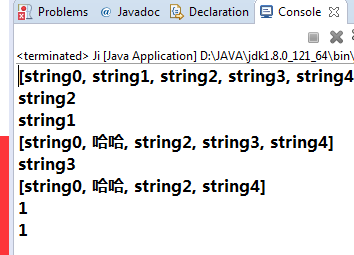Collection---接口:
Set接口
*HashSet---实现类(以哈希码表为底层的实现机制)
TreeSet---实现类(以二叉树(一种数据结构)为底层的实现机制)
没有顺序, 不可以重复(可以互相equals就叫重复)
List接口
*ArrayList---实现类(以数组为底层的实现机制)
LinkedList---实现类(以链表为底层的实现机制)
有顺序, 可以重复
Map接口(键值对)
*HashMap---实现类
TreeMap---实现类
每次往里放的时候都是一对一对的
Collection接口的方法
Collection接口的使用
Collection<String> c = new ArrayList<String>();
问题: 为什么不直接写ArrayList<String> a = new ArrayList<String>();
c.add(参数类型必须是Object)
c.remove方法: 通过判断两个对象是否互相的equals来确定是不是该删除该对象, 自定义的类, 需要自己重写父类的equals方法
重写equals方法, 也应该重写hashCode方法
hashCode通常用来做索引, 一个对象通过它的hashCode的值可以找到它在内存中的地址, 所以两个对象如果equals了, 而且又要作为索引的情况下, hashCode的值必须相等
List接口:
ArrayList(API中说初始容量为10的, 注意这个问题), LinkedList
有顺序, 可以重复添加
get
set(有一个返回值要注意 !)
add
remove(int)
remove(Object)
indexOf
lastIndexOf
retainAll(Collection)----返回一个boolean值, 当list的内容被改变的时候返回true, 否则返回false
Map接口
HashMap(哈希表做索引), TreeMap(二叉树做索引)
键值对(键不能重复, 什么情况算是重复)
put
get
remove
containsKey
containsValue
size
isEmpty
putAll
clear
public class Ji {
public static void main( String[ ] args){
List list1 = new ArrayList();
for (int i = 0; i < 5; i++) {
list1.add("string" + i);
}
System.out.println(list1);
System.out.println(list1.get(2));
System.out.println(list1.set(1,"哈哈"));
System.out.println(list1);
System.out.println(list1.remove(3));
System.out.println(list1);
System.out.println(list1.indexOf("哈哈"));
System.out.println(list1.lastIndexOf("哈哈"));
}

public class Ji {
public static void main( String[ ] args){
/*List list1 = new ArrayList();
for (int i = 0; i < 5; i++) {
list1.add("string" + i);
}
System.out.println(list1);
System.out.println(list1.get(2));
System.out.println(list1.set(1,"哈哈"));
System.out.println(list1);
System.out.println(list1.remove(3));
System.out.println(list1);
System.out.println(list1.indexOf("哈哈"));
System.out.println(list1.lastIndexOf("哈哈"));
}
*/
Map map = new HashMap( );
for (int i = 0; i < 5; i++) {
map.put(i, new Person("name"+ i ));
}
System.out.println(map);
map.put(5, new Person("新人"));
System.out.println(map);
map.put(1, new Person("又来个新人"));
System.out.println(map);
System.out.println(map.get(2));
System.out.println(map.remove(1));
System.out.println(map);
System.out.println(map.remove(0, new Person("name0")));
System.out.println(map);
System.out.println(map.containsKey(4));
System.out.println(map.containsValue(new Person("name0")));
System.out.println(map.size());
System.out.println(map.isEmpty());
}
class Person{
String name;
public Person( String name){
this.name = name;
}
}
}